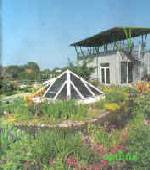An unprotected home loses much more heat on a cold, windy day than on an
equally cold, still day. Well-located trees and shrubs can intercept the wind
and cut heat loss. Up to one-third of the heat loss may escape through the walls
and roof by conduction. Wind also increases the convective air currents along
outside walls and roof thus increasing heat loss.
Infiltration or air leakage can account for as much as one-third of heating
losses in some buildings. Cold, outside air flows in through cracks around
windows and doors, and even through pores in walls. This produces drafts that
may cause you to compensate by raising the thermostat to unreasonable levels
just to maintain a modicum of comfort. Both windbreaks and foundation plantings
can cut down the penetrating power of the wind.
Windbreak Benefits

Studies of windbreaks show that windbreaks can reduce winter fuel consumption
by 10 to 30 percent. One study in Nebraska compared fuel requirements of
identical test houses which maintained a constant inside temperature of 70
degrees F. The house protected by a windbreak used 23 percent less fuel. In 1
month, an exposed, electrically heated house in South Dakota used 443
kilowatt-hours to maintain an inside temperature of 70 degrees F. An identical
house sheltered by a windbreak used only 270 kilowatt-hours. The difference in
average energy requirements for the whole winter was 34 percent.
The amount of money saved by a windbreak will vary depending on the climate
of the area, location of the home, and the construction material and quality. A
well-weatherized house with adequate ventilation won't benefit from windbreaks
as much as a poorly weatherized house. In addition to reducing the force of the
wind, windbreaks also can reduce the wind-chill impact on people outside the
house.
Windbreaks can be located to control snow too, reducing the energy required
to remove snow from around homes, buildings, and roads. Make sure windbreaks are
located correctly to have the desired effect on drifting snow.
The height and density of trees determine the amount of protection they will
provide. Windbreaks of 2 to 5 rows of trees and shrubs generally provide good
protection. Evergreen trees provide the best protection, although low, branching
deciduous trees can significantly reduce wind speed. Even a single row of
evergreen trees will give some protection.
Windbreaks reduce wind velocity significantly for a distance of about 10
times the height of the trees. Maximum protection is provided within a distance
of 5 times the height of the trees. Thus a windbreak 30 feet high protects an
area extending as far as 300 feet downwind and some protection is provided for
as far as 20 times the height of the trees.
Foundation Planting
Trees and shrubs planted close to buildings reduce wind currents that
otherwise would chill the outside surface. Foundation plantings create a
"dead air" space which slows the escape of heat from a building. These
plantings also help reduce air infiltration around the foundation of the house.
Evergreen trees and shrubs are thicker and are more effective than deciduous
plants. To be most effective, the evergreens should be planted close together to
form a tight barrier. In summer, the same dead air space helps insulate your
home from hot, outside air reducing the need for air conditioning.
![]() Gardeners' Corner
Kids'
Garden
Sustainable Garden
Contact Us
Gardeners' Corner
Kids'
Garden
Sustainable Garden
Contact Us![]()



